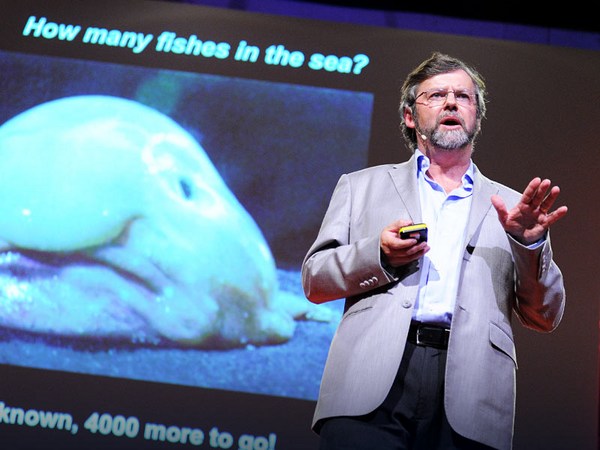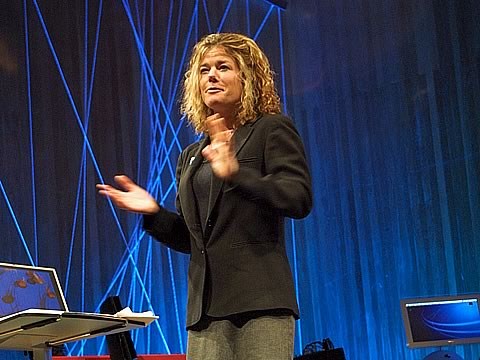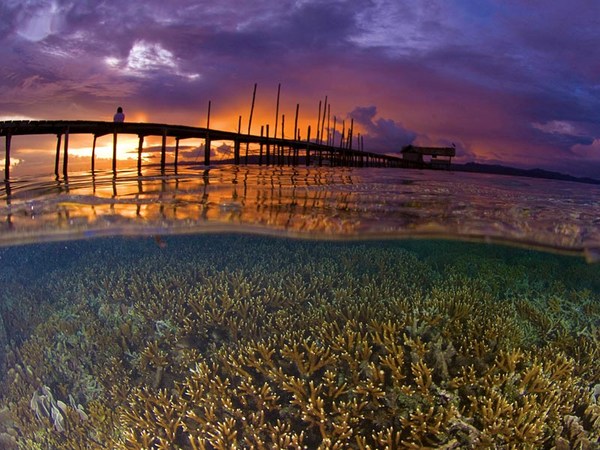Right now, beneath a shimmering blue sea, millions of fish are having sex. (Cheers) And the way they're doing it and strategies they're using looks nothing like what we see on land. Take parrotfish. In this species, all fish are born female. And they look like this. Then later in life, she can transition into a male. And she'll look like this. But, it's not just a spectacular wardrobe change. Her body can reabsorb her ovaries and grow testes in their place. In just a few weeks, she'll go from making eggs to producing sperm. It's pretty impressive, and in the ocean, it's also pretty common. In fact, I bet nearly all of you have, at some point, had a seafood dish made up of an individual that started life as one sex and transitioned to another: oysters, grouper, shrimp, Seeing some heads nodding, yeah? But not all fish that change sex start as females. Those clownfish we know from Finding Nemo ... they're all born male. So, in the real world, when Nemo's mother died, Nemo's dad, Marlin, would have transitioned into Marlene, (Laughter) and Nemo would have likely made it with his father-turned-mother. (Laughter) You can see - (Laughter) You can see why Pixar took a little creative license with the plotline, right? (Laughter) So sex change in the ocean can happen in either direction and sometimes, even back and forth. And that's just one of the many amazing strategies animals use to reproduce in the ocean. And trust me when I say, it's one of the least surprising. Sex in the sea is fascinating. And it's also really important and not just to nerdy marine biologists like me who are obsessed with understanding these salty affairs. (Laughter) It matters for all of us. Today we depend on wild caught fish to help feed over 2 billion people on the planet. We need millions of oysters and corals to build the giant reefs that protect our shorelines from rising seas and storms. We depend on medicines that are found in marine animals to fight cancer and other diseases. And for many of us, the diversity and beauty of the oceans is where we turn for recreation and relaxation and our cultural heritage. In order for us to continue to benefit from the abundance that ocean life provides, the fish and coral and shrimp of today have to be able to make fish and shrimp and coral for tomorrow. To do that, they have to have lots and lots of sex. (Laughter) And until recently, we really didn't know how sex happened in the sea. It's pretty hard to study. But thanks to new science and technology, we now know so much more than even just a few years ago. And these new discoveries are showing two things: First, sex in the sea is really funky. (Laughter) Second, our actions are wreaking havoc on the sex lives of everything from shrimp to salmon. So today, I'm going to share a few details about how animals do it in the deep, how we may be interrupting these intimate affairs, and what we can do to change that. So, remember those sex-changing fish? In many places in the world, we have fishing rules that set a minimum catch size. Fishers are not allowed to target tiny fish. This allows baby fish to grow and reproduce before they're caught. That's a good thing. So fishers go after the biggest fish, but in parrotfish, for example, or any sex changer, targeting the biggest fish means that they're taking out all the males. That makes it hard for a female fish to find a mate, or it forces her to change sex sooner, at a smaller size. Both of these things can result in fewer fish babies in the future. In order for us to properly care for these species, we have to know if they change sex, how, and when? Only then can we create rules that can support these sexual strategies, such as setting a maximum size limit in addition to a minimum one. The challenge isn't that we can't think of these sex-friendly solutions. The challenge is knowing which solutions to apply to which species because even animals we know really well surprise us when it comes to their sex lives. Take Maine lobster. They don't look that romantic ... (Laughter) or that kinky. They are both. (Laughter) During mating season, female lobsters want to mate with the biggest, baddest males, but these guys are really aggressive, and they'll attack any lobster that approaches - male or female. Meanwhile the best time for her to mate with the male is right after she's molted, when she's lost her hard shell. So she has to approach this aggressive guy in her most vulnerable state. What's a girl to do? (Laughter) Her answer? Spray him in the face, repeatedly, with her urine. (Laughter) Under the sea, pee is a very powerful love potion. (Laughter) Conveniently, lobsters' bladders sit just above their brains, and they have two nozzles under their eye stalk with which they can shoot their urine forward. (Laughter) So the female approaches the male's den, and as he charges out, she lets loose a stream of urine, and then gets the hell out of there. (Laughter) Only a few days of this daily dosing is all it takes for her scent to have a transformative effect. The male turns from an aggressive to a gentle lover. By the week's end, he invites her into his den. (Laughter) After that, the sex is easy. (Laughter) So how are we interrupting this kind of kinky courtship? Well, the female's urine carries a critical chemical signal that works because it can pass through seawater, and lobsters have a smell receptor that can detect and receive the message. Climate change is making our oceans more acidic. It's the result of too much carbon dioxide entering seawater. This changing chemistry could scramble that message or it could damage the lobster's smell receptors. Pollution from land can have similar impacts. Just imagine the consequence for that female if her love potion should fail. These are the kinds of subtle but significant impacts we're having on the love lives of these marine life. And this is a species we know well. Lobsters live near shore in the shallows. Dive deeper, and sex gets even stranger. Fanfin anglerfish live at about 3000 feet below the surface in pitch-black waters, and the males are born without the ability to feed themselves. To survive, he has to find a female fast. Meanwhile the female, who is 10 times bigger than the male, 10 times, she lets out a very strong pheromone with which to attract mates to her. So this tiny male is swimming through the black waters, smelling his way to a female. And when he finds her, he gives her a love bite. And this is when things get really weird. (Laughter) That love bite triggers a chemical reaction whereby his jawbone starts to disintegrate. His face melts into her flesh, and their two bodies start to fuse. Their circulatory systems entwine, and all his internal organs start to dissolve, except for ... his testes. (Laughter) His testes mature just fine and start producing sperm. In the end, he's basically a permanently-attached, on-demand sperm factory for the female. (Laughter) It's a very efficient system, (Laughter) but this is not the kind of mating system that we see on a farm, right? I mean this is weird; it's really strange. But if we don't know that these kind of strategies exist, or how they work, we can't know what kind of impacts we may be having, even in the deep sea. Just three years ago, we discovered a new species of deep-sea octopus where the females lay their eggs on sponges attached to rocks that are over two and a half miles deep. These rocks contain rare-earth minerals, and right now, there are companies that are building bulldozers that would be capable of mining the deep-sea floor for those rocks, but the bulldozers would scrape up all the sponges and all the eggs with them. Knowingly and, in many cases, unknowingly, we are preventing successful sex and reproduction in the deep. And let's be honest, dating and mating is hard enough without somebody coming in and interrupting all the time, right? We know this. So today, while I hope you will leave here with some excellent bar trivia on fish sex, (Laughter) I also ask that you remember this: We are all far more intimately connected with the oceans than we realize, no matter where we live. And this level of intimacy requires a new kind of relationship with the ocean. One that recognizes and respects the enormous diversity of life and its limitations. We can no longer think of the oceans as just something "out there," because every day, we depend on them for our food security, our own health and wellness, and every other breath we take. But it is a two-way relationship, and the oceans can only continue to provide for us if we, in turn, safeguard that fundamental force of life in the sea: sex and reproduction. So like any relationship, we have to embrace some change for the partnership to work. The next time you're thinking about having seafood, look for sustainably caught or farmed species that are local and low on the food chain. These are animals like oysters, clams, mussels, small fish like mackerel. These all reproduce like crazy and with good management, they can handle a bit of fishing pressure. We can also rethink what we use to wash our bodies, clean our homes, and care for our lawns. All those chemicals eventually wash out to sea and disrupt the natural chemistry of the ocean. Industry also has to play its part and take a precautionary approach, protecting sexual activity where we know it exists and preventing harm in the cases where we just don't yet know enough, like the deep sea. And in the communities where we live, the places we work, and the country in which we vote, we must take bold action on climate change now. (Applause) (Cheers) Never has it been more important nor more possible to fight for the solutions that we know already exist. But time is running out for lobster seduction and coral sex parties and so many other animals that depend on just the right temperature and chemistry for peak sexual performance. I know sometimes it can feel like the problem is as big as the ocean, but remember, nature is on our side. Animals want to reproduce. In fact, we've even discovered some female sharks and rays that when they can't find a mate, they go off and reproduce all on their own. It's real-life virgin birth. Fascinating. Unfortunately, the strategy can't save the species in the long term - sex between males and females is needed for that genetic diversity, but the tactic can buy a population time. And it just goes to show that in the sea, reproduction and sex are truly a force of nature. And the animals are doing their part. Imagine if we did ours and worked with this force rather than against it. We can help set the mood and then step back and allow today's, tomorrow's, and future generations of fish and all ocean life the freedom to do what they do best ... get their spawn on! (Laughter) Thank you. (Applause)





